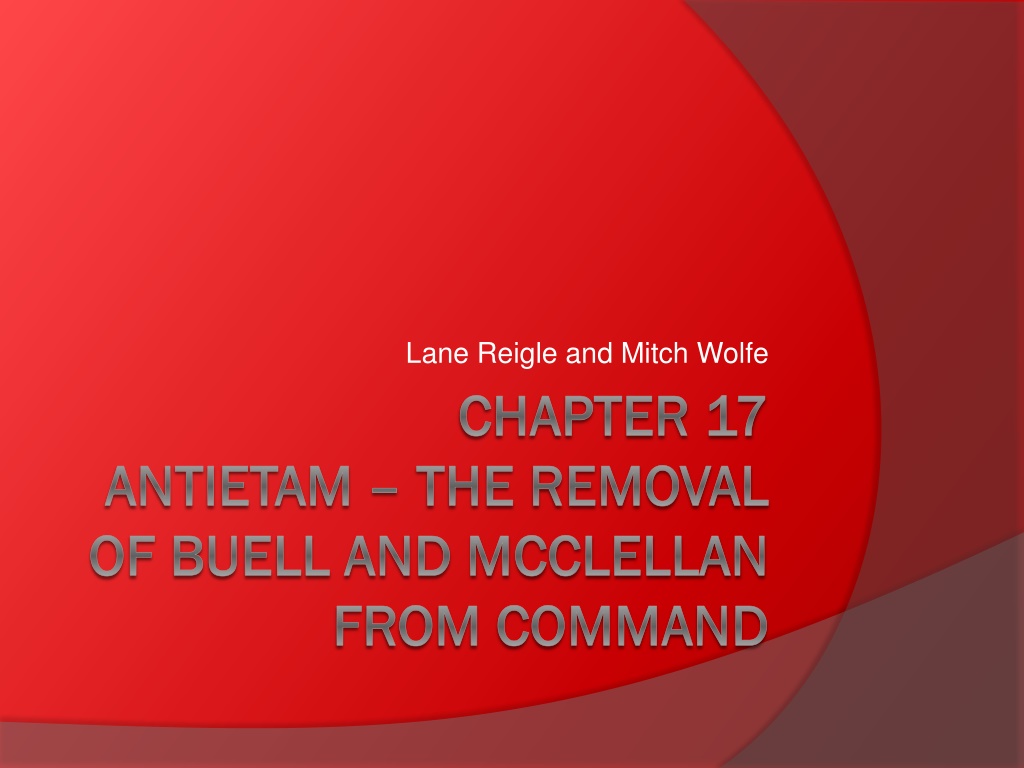The Battle of Antietam: Removal of Buell and McClellan from Command
The Battle of Antietam, also known as the Battle of Sharpsburg, had significant casualties with more killed or wounded in one day than in multiple previous wars. The battle involved key areas such as The Cornfield, The Woods, The Sunken Road, and Rohrbach Bridge. It ended as a tactical draw but a strategic defeat for the Confederates. The aftermath saw the Confederate invasion of Kentucky with Beauregard being replaced by Bragg as the Commander of the Army of the Mississippi. The Battle of Perryville ensued shortly after, characterized by intense fighting and casualties.
Download Presentation

Please find below an Image/Link to download the presentation.
The content on the website is provided AS IS for your information and personal use only. It may not be sold, licensed, or shared on other websites without obtaining consent from the author. Download presentation by click this link. If you encounter any issues during the download, it is possible that the publisher has removed the file from their server.
E N D
Presentation Transcript
Lane Reigle and Mitch Wolfe CHAPTER 17 CHAPTER 17 THE REMOVAL ANTIETAM ANTIETAM THE REMOVAL OF BUELL AND MCCLELLAN OF BUELL AND MCCLELLAN FROM COMMAND FROM COMMAND
Antietam Historical Music Video http://www.youtube.com/watch?v=bHAw _8cVPCs Quote on page 304
Statistics Approximately 23,000 casualties at the Battle of Sharpsburg 6000 American casualties on D-Day in WWII More killed/mortally wounded in one day at Sharpsburg than in the War of 1812, the Mexican War, and the Spanish- American War combined In comparison, approximately 3000 killed on September 11, 2001
The Battle of Sharpsburg (Sep. 17) 3 Part Battle The Cornfield/ The Woods The Sunken Road Rohrbach Bridge
The Cornfield/ The Woods Area of first fighting Taken by Union, repulsed, then taken again General Mansfield killed, Hooker wounded Quote on page 306
The Sunken Road Held by the Confederates for 3 hours of fighting Confused order led to break in formation Forever known as Bloody Lane
Rohrbach (Burnside) Bridge Union attempts to cross Antietam Creek Fordable at several places, but Burnside focused on the single bridge Finally broke through, didn t pursue until 3 p.m.
Outcome Tactical Draw Strategic defeat for Confederates Quote on page 311
Confederate Invasion of Kentucky Beauregard replaced by Bragg as Commander of Army of the Mississippi Confederacy thought Kentuckians would be eager for liberation Smith/ Bragg took 15,000 rifles along to arm supporters Smith captured Richmond
The Battle of Perryville (Oct. 7) Fought over water Philip Sheridan Polk rolled up left flank, killing 2 generals Acoustic Shadow Union casualties= 4200 Confederate casualties= 3400
The Battles of Iuka (Sep. 19) and Corinth (Oct. 3) Grant planned pincer to trap confederates in Iuka Rosecrans attacked by Price while Ord had no idea (acoustic shadow) Van Dorn/ Price attack Rosecrans at Corinth Union casualties= 3300 Confederate casualties= 5700
The Preliminary Emancipation Proclamation September 22, 1862 Quote on page 316 In effect January 1, 1863 Unsure of country s response, Lincoln took a conservative approach Emancipation necessary means of winning the war Cushioned shock Quote on page 317
Lincoln and Civil Liberties Lincoln suspended the writ of Habeas Corpus Military control of telegraph to censor reports State Department originally responsible for internal security; Lincoln transferred responsibility to War Department February 1862
Lincoln and Civil Liberties (Cont.) Stanton reduced arrests Trials made for imprisoned At least 15000 arrested during war Arresting deserters, draft evaders, etc. = good Arresting editors, public officials, etc. = bad Quote on page 318
The Elections of 1862 in the North Democrats want to turn around on Republicans before Jan. 1 Quote on page 319 Republicans retained Congress Emancipation made requirement for WV statehood Quote on page 321 Emancipation just a Yankee trick
The Removal of McClellan and Buell from Command Staff urged McClellan to march on Washington for EP Quote on page 322 Military shortcomings did McClellan in; thought he had fought a masterpiece at Sharpsburg Stuart raided up to Chambersburg Quote on page 324
The Removal of McClellan and Buell from Command (Cont.) McClellan removed from command on November 7, 1862 Burnside replaced him reluctantly Buell permitted enemy to escape, men dislike him Replaced by William S. Rosecrans
Europe and the War, 1862 Palmerston wanted to wait until after Maryland invasion Loss at Antietam delayed possible foreign support Napoleon III proposed joint British, French, and Russian armistice Quote on page 326

 undefined
undefined



























